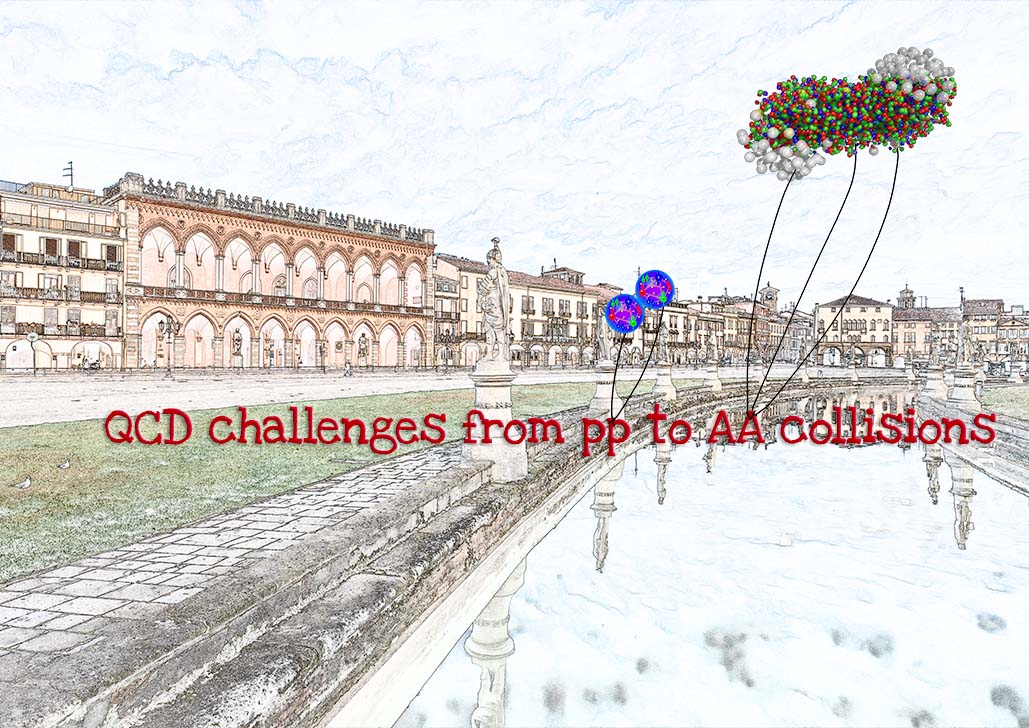In this workshop open questions on phenomena observed in proton-proton, proton-ion and ion-ion collisions that challenge our understanding and usage of QCD will be discussed. People from different communities and experiments are brought together to share ideas and lively discuss with the goal of proposing possible actions, new theoretical directions, and measurements that could allow for progresses on these open problems. The programme is articulated in six different tracks, representative of some of the many QCD topics that are currently more actively discussed:
1) Initial state and ultraperipheral
2) Jet production and properties in pp and in the medium
3) Event properties and hydro in small and large systems
4) Hadronization of light and heavy flavour across collision systems
5) Energy loss in the medium and in small system
6) QCD and astrophysics
-
1) Initial state and ultraperipheral
In this track proton and nuclear Parton Distribution Functions, and low-x physics in pp, pA and AA collisions are discussed. Main topics will be ultra-peripheral collisions, diffractive physics, color-glass condensate, intrinsic charm.
Conveners: Jesus Guillermo Contrera Nuno (Prague, CTU), Petja Paakkinen (Jyvaskyla U.), Thomas Boettcher (Cincinnati U.)
-
2) Jet production and properties in pp and in the medium
Measurements of jet production and jet properties, along with their modifications in the medium, are important tests of QCD. Jet mass, shapes, as well as the jet content can be studied and compared with state-of-the-art QCD predictions. The jet substructure can also be exploited to tag quark/gluon jets. In this track the most important jet observables that can be used to validate fragmentation models will be addressed. Heavy-flavour jets will also be discussed.
Conveners: Alba Soto Ontoso (CERN), Leticia Cunqueiro Mendez (Rome U., INFN), Martin Spousta (Charles U.)
-
3) Event properties and hydro in small and large systems
Themes of this session are the global properties of small and extended systems formed in proton-proton, proton-nucleus, and nucleus-nucleus collisions. Multiplicity- and centrality-differential measurements of particle production, flow, correlations, and their description in hydrodynamical and non-perturbative soft QCD models will be discussed. Strangeness enhancement in different systems will also be addressed.
Conveners: Aleksas Mazeliauskas (U. Heidelberg, ITP), David Chinellato (Estadual de Campinas U., IFGW), Lucia Oliva (Catania U.,INFN)
-
4) Hadronization of light and heavy flavour across collision systems
This track is dedicated to the discussion of the hadronization of both light and heavy quarks. Measurements of hadron multiplicities, particle-species ratios and momentum/rapidity-differential spectra will be reviewed to get insight into the hadronization process and its modification from e+e- and ep collisions to pp and nucleus-nucleus collisions. Different models describing recent observations of a modification of heavy-flavour baryon-to-meson ratios from e+e- to hadronic collision systems are based on different processes and concepts that could ideally be related. A second main topic is spectroscopy, with focus on recent observations of excited heavy-baryon states as well as tetraquark and pentaquark candidates along with the theoretical interpretation of nature of these states.
Conveners: Anton Andronic (Darmstadt, GSI), Jing Wang (MIT), Peter Skands (Monash U.), Vincenzo Greco (Catania U. and INFN)
-
5) Energy loss and transport in the medium and in small systems
Despite the impressive progresses on both the experimental and theoretical side in the last twenty years, a fully satisfactory description of in-medium energy loss and related phenomena has not been reached yet. Still challenging is the comprehensive description of RAA and flow data of several particles, which provide sensitivity to the energy-loss process and to its dependence on parton colour-charge and mass. Furthermore, the observation of collective effects in small systems without sizeable signs of energy loss is a major puzzle yet to be solved. In this track, related measurements, open points in QCD-based models, and possible future directions will be discussed.
Conveners: Andrea Dainese (INFN Padova), Andreas Morsch (CERN), Francesco Prino (INFN Turin)
-
6) QCD and astrophysics
In this track the QCD measurements performed at colliders that are relevant for cosmic rays and other astrophysical studies will be discussed. These ranges from cross-section measurements that can be used to understand the origin of cosmic rays, to the properties that can shed light on neutron-star core and stellar evolution, as well as the possible implications of lattice QCD calculations for the Early Universe.
Conveners: Hans Dembinski (Dortmund U.), Ramona Lea (Brescia U., INFN), Saverio Mariani (CERN)
